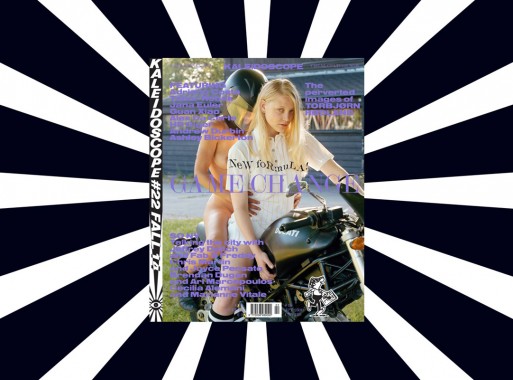
KALEIDOSCOPE Magazine 22, Fall 2014
Softcover, 256 pp. + Ari Marcopoulos poster, offset 4/4, 230 x 300 mm
English edition
ISSN 2038-4807
Published by KALEIDOSCOPE Press
$18.00 ·
Kaleidoscope’s newest release, Issue 22 (Fall 2014), introduces a completely redesigned and revamped version of the magazine, under the visionary art direction of Munich-based Bureau Mirko Borsche. The magazine’s new direction combines its defining curatorial and interdisciplinary approach with an emphasis on the power of images and a keen attention to the update, and is best epitomized by the new cover tagline: VISUAL CULTURE NOW.
In the renovated opening section of HIGHLIGHTS, twelve profiles account for the best of the season: Boychild (by Francesca Gavin), Ed Fornieles (by George Vasey), Adriano Costa (by Laura McLean-Ferris), Liu Chuang (by Venus Lau), Carol Rama (by Jesi Khadivi), Tabor Robak (by Alex Gartenfeld), Jana Euler (by Martha Kirszenbaum), Guan Xiao (by Pablo Larios), Alex Da Corte (by Piper Marshall), David Ostrowski (by Peter J. Amdam), Aphex Twin (by Francesco Tenaglia), and Torey Thornton (by Ross Simonini).
To follow, our signature MAIN THEME section, titled SO NY, is dedicated to practices informed and inspired by the city of New York. From the gritty urban feeling to the great sense of community — living and working in NYC provides endless inspiration and fuel for artists and creators. We have selected four pairs, from different generations and circles, to share memories and discuss perspectives: Jeffrey Deitch and Fab 5 Freddy, Chris Martin and Joyce Pensato, Brendan Dugan and Ari Marcopoulos, and Cecilia Alemani and Marianne Vitale. The result is a choral tale of convergences, strategies, connections, and old and new magics. Enriched with a collectable poster by Ari Marcopoulos!
On the other hand, the MONO section and cover story are dedicated to Norwegian, Los Angeles-based photographer Torbjørn Rødland. Seemingly speaking the fetishistic idiom of advertisement, marketing and food photography, Rødland’s images are in fact pervaded by the most compelling kind of perversity and haunted by boredom, spiritual longing, and a sense of aftermath. This monographic survey comprises an essay by Chris Sharp, an interview by Hanne Mugaas, and original portraits by Trine Hisdal.
Later on, a brand new section invites the eye to an enthralling journey across over 80 pages of visual contributions by artists, curators and image-makers, affirming the magazine’s centrality as a tool to show and experience art. This issue’s VISIONS include “Chopped & Screwed: Austin Lee and David Benjamin Sherry,” curated by Alessio Ascari; H.R. Giger’s “Biomechanoid”; Dorothea Tanning’s “Paintings”; Alexandra Bachzetsis’s “From A to B via C”; “Rondes Bosses,” curated by Nicolas Trembley; Chris Wiley’s “Technical Compositions”; and David Rappeneau’s “$$$$$$$$$$$$$$$$$$$$$$$$$$$.”
Lastly, the closing section of REGULARS features our insightful columns on the past, present and future of art and culture: in the first installment of Futura 89+ Hans Ulrich Obrist and Simon Castets interview American poet Andrew Durbin; Producers features Carson Chan’s conversation with Artsy’s founder Carter Cleveland; Christopher Schreck explores Francesco Clemente’s India as part of the Panorama series; and in Pioneers Fredi Fischli and Niels Olsen talk to legendary artist Ashley Bickerton.
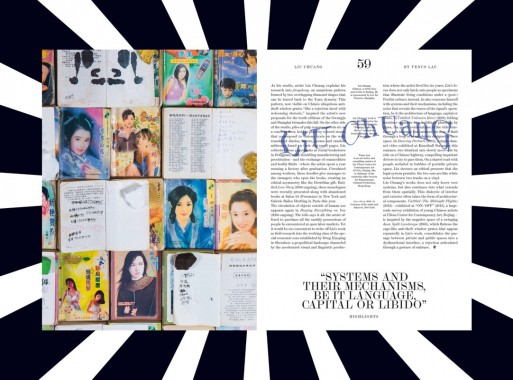
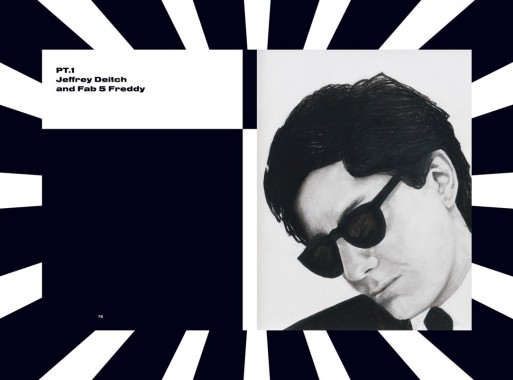
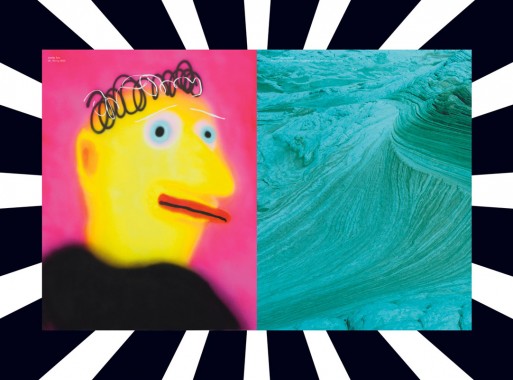
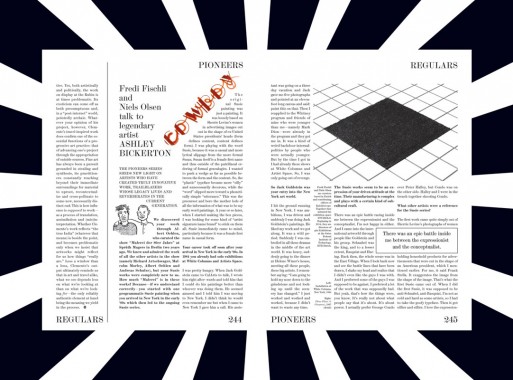
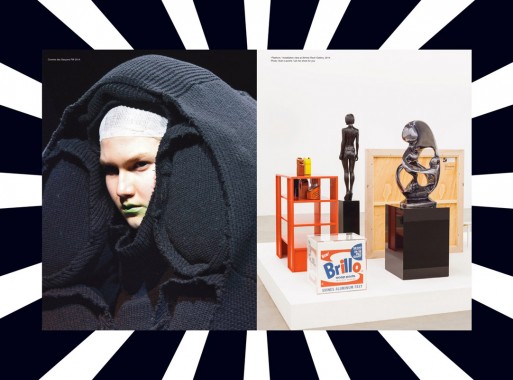
Adriano Costa, Alessio Ascari, Alex Da Corte, Alex Gartenfeld, Alexandra Bachzetsis, Andrew Durbin, Aphex Twin, Ari Marcopoulos, Art, Ashley Bickerton, Austin Lee, Brendan Dugan, Carol Rama, Carson Chan, Carter Cleveland, Cecilia Alemani, Chris Martin, Chris Sharp, Chris Wiley, Christopher Schreck, Culture, David Benjamin Sherry, David Ostrowski, David Rappeneau, Distribution, Dorothea Tanning, Ed Fornieles, Fab 5 Freddy, Francesca Gavin, Francesco Clemente, Francesco Tenaglia, Fredi Fischli, George Vasey, Guan Xiao, H.R. Giger, Hanne Mugaas, Hans Ulrich Obrist, Jana Euler, Jeffrey Deitch, Jesi Khadivi, Joyce Pensato, KALEIDOSCOPE Press, Laura McLean-Ferris, Liu Chuang, Marianne Vitale, Martha Kirszenbaum, Mirko Borsche, Nicolas Trembley, Niels Olsen, Pablo Larios, Peter J Amdam, Piper Marshall, Ross Simonini, Simon Castets, Tabor Robak, Torbjørn Rødland, Torey Thornton, Trine Hisdal, Venus Lau
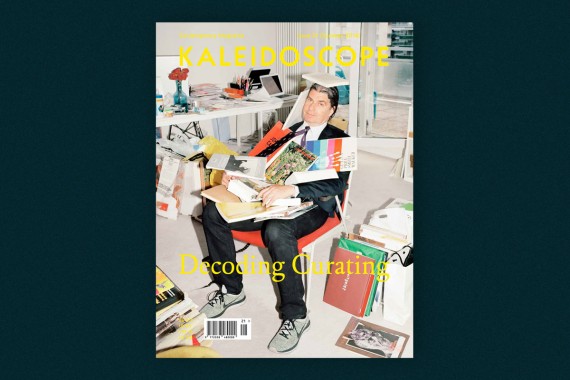
KALEIDOSCOPE Magazine 21, Decoding Curating
Softcover, 234 pp. + three special inserts, offset 4/4, 220 x 287 mm
English edition
ISSN 2038-4807
Published by KALEIDOSCOPE Press
$18.00 ·
KALEIDOSCOPE’s newest issue, Issue 21 (Summer 2014), is a special edition dedicated to curating, aimed to decode the dynamics and implications of the profession — from funding to theoretical propositions, from circulation to consciousness-raising and from trend forecasting to commodification — and imagine its possible future developments.
In the opening section of HIGHLIGHTS, we have selected five emerging, ’80s-born practitioners from different backgrounds and continents — Alex Gartenfeld, Sarah Rifky, Hanne Mugaas, Anthony Yung and Luca Lo Pinto — representing a glimpse into the multiplicity of visions and motivations behind, as well as approaches to, the curatorial practice.
To follow, the MAIN THEME section comprises four extensive discussions, involving as many as twenty-five international professionals — including Adam Szymczyk, Sarah McCrory, Lauren Cornell, Dena Yago and Mitchell Algus — to comment on how curating unfolds in such diverse frameworks as the not-for-profit organization, the large-scale exhibition, the Internet, and the commercial gallery.
Surprisingly, on the other hand, the MONO section and cover story are dedicated to an artist, Swiss living legend John Armleder — with a comprehensive interview by Andrea Bellini, an essay by Jeanne Graff and a portrait by Mathilde Agius — as a means to account for an organic and unconstrained approach to all sides of creative production and to hint at the long and enthralling tradition, of Duchampian descent, of artist/curators.
Lastly, the closing section of REGULARS features interviews exploring to what extent curatorial practice has strayed into other fields, such as architecture, cuisine and radio broadcasting: Hans Ulrich Obrist interviews NTS founder Femi Adeyemi; Fredi Fischli and Niels Olsen talk appropriating exhibitions with cult curator Bob Nickas; Jesi Khadivi discusses the art scene in L.A. with man-about-town Michael Ned Holte; Carson Chan meets Venice Architecture Biennale’s key contributor Stephan Trüby; and Francesca Gavin interrogates editor Emma Robertson and promoter Alessandro Porcelli on the art of food.
This issue is enriched by our seasonal TIPS on reading, listening, stopping by, meeting and visiting; as well as three visual INSERTS, specially commissioned as so many experiments of exhibitions on paper: “Portraits of Society” curated by Nicholas Cullinan, ”Robert Mapplethorpe” curated by Elad Lassry, and “Coupling” curated by Piper Marshall.
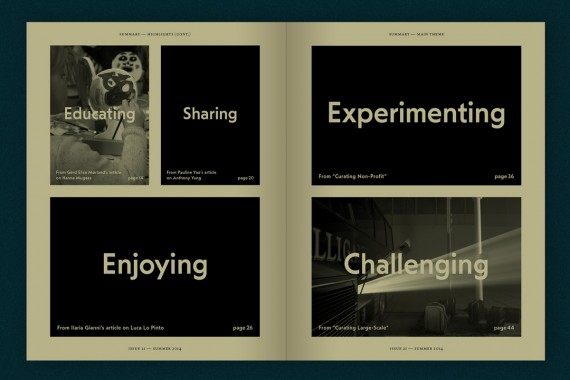
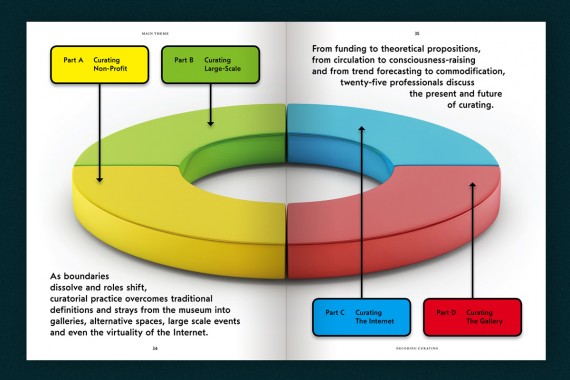
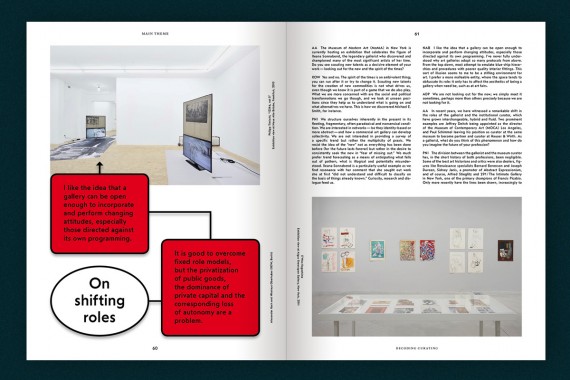
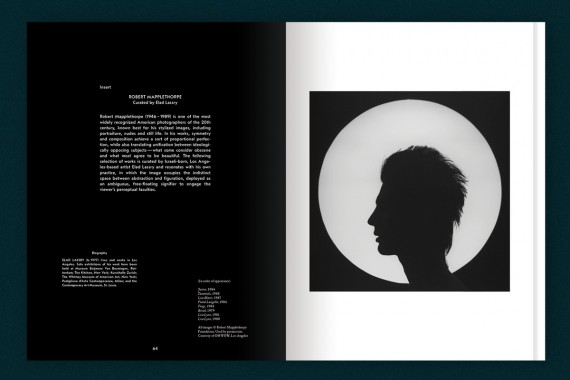
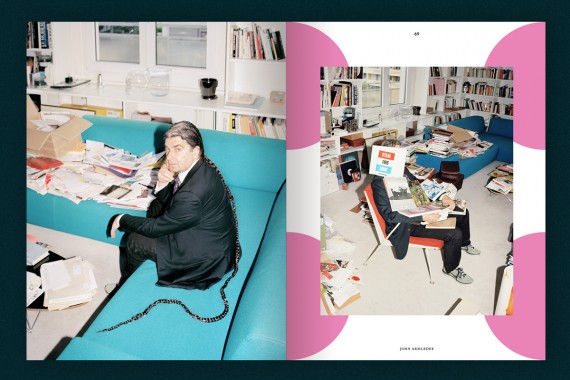
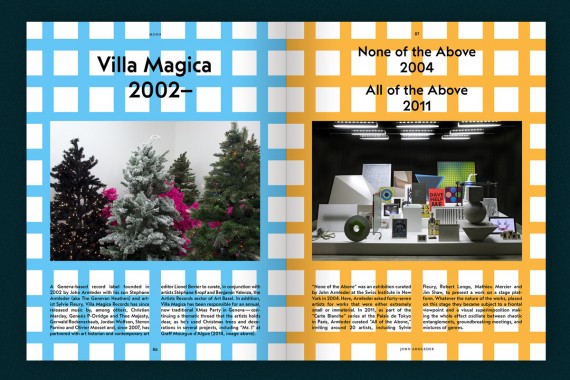
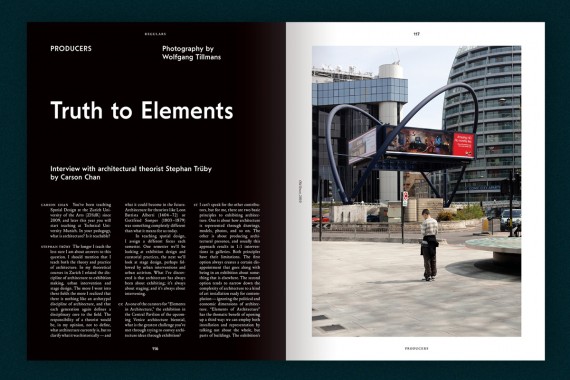
Adam Szymczyk, Alessandro Porcelli, Alex Gartenfeld, Andrea Bellini, Anthony Yung, Art, Bob Nickas, Carson Chan, Culture, Curatorial, Dena Yago, Distribution, Elad Lassry, Emma Robertson, Femi Adeyemi, Francesca Gavin, Fredi Fischli, Hanne Mugaas, Hans Ulrich Obrist, Jeanne Graff, Jesi Khadivi, John Armleder, KALEIDOSCOPE Press, Lauren Cornell, Luca Lo Pinto, Mathilde Agius, Michael Ned Holte, Mitchell Algus, Nicholas Cullinan, Niels Olsen, Piper Marshall, Robert Mapplethorpe, Sarah McCrory, Sarah Rifky, Stephan Trüby
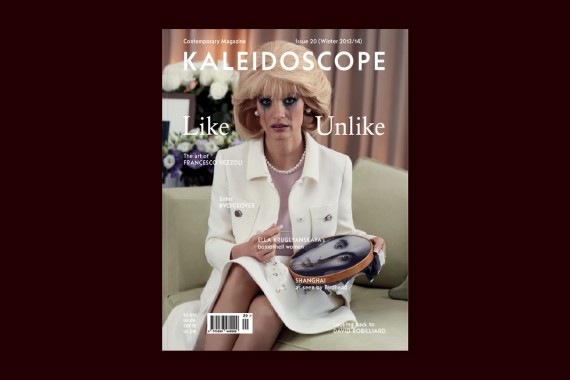
KALEIDOSCOPE Magazine 20 — Winter 2014
Softcover, 242 pp. + three special inserts, offset 4/4, 220 x 287 mm
English edition
ISSN 2038-4807
Published by KALEIDOSCOPE Press
$18.00 ·
The opening section of HIGHLIGHTS features Latvian-born painter Ella Kruglyanskaya (words by Chris Sharp); Danish performer Christian Falsnaes (interview by Raimar Stange); American painter Ned Vena (words by Mathieu Malouf); British artist Haroon Mirza (interview by Thom O’Nions); and Berlin-based Loretta Fahrenholtz (words by Michele D’Aurizio).
Edited by Kaleidoscope’s editor-in-chief Alessio Ascari and entitled #VOICEOVER, the MAIN THEME section is dedicated to the deployment of off-camera commentary as a conceptual device in moving image works. The survey presents an overview by Shama Khanna on a new generation of artists, including Ed Atkins, Camille Henrot, Pilvi Takala, Duncan Campbell and Laure Prouvost; a case study by Pablo Larios on Jordan Wolfson; an essay by Marie de Brugerolle on French filmmakers Chris Marker and Jean-Luc Godard; and a conversation between Oliver Laric and George Vasey on voiceover in the pop realm.
Riding the edge of contemporary art and show business, the controversial work of Francesco Vezzoli, our cover story and the subject of the MONO section, occupies a schizophrenic space between pop and conceptualism, high and low, cynicism and criticality. The section comprises an essay by Andrea Viliani, an interview by Kevin McGarry, and a visual project specially created by the artist based on Grindr profiles.
A selection of videos featured in the Mono and Main Theme sections will be soon available to watch on KALEIDOSCOPE Videoclub, our new online channel of video exhibitions. Stay tuned!
Lastly, this issue’s section of REGULARS features Hans Ulrich Obrist introducing Swiss artist Kaspar Müller; Carson Chan meeting young global curator Simon Castets; Davide Quadrio reporting on the art scene in Shanghai, in conversation with local duo Birdhead; Fredi Fischli and Niels Olsen rediscovering the art of Chicago artist Christina Ramberg in conversation with Albert Oehlen; and Matthew Erickson inaugurating a new series of articles focused on single art works, Close-up, with an in-depth look at Matthew Barney’s latest project, River of Fundament.
The issue is enriched by our seasonal TIPS on following, reading, listening, stopping by, meeting and visiting; as well as by three SPECIAL INSERTS by Belgian collective Leo Gabin, British maverick David Robilliard and Japanese legendary illustrator Hajime Sorayama.
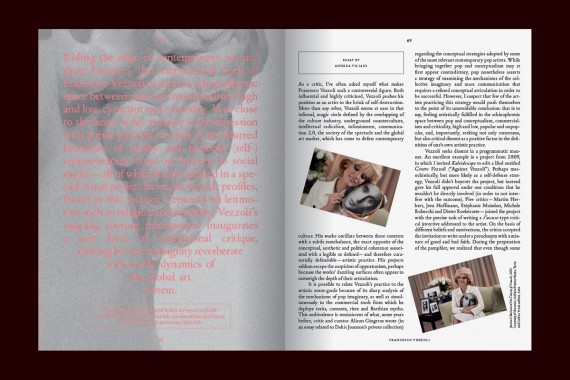
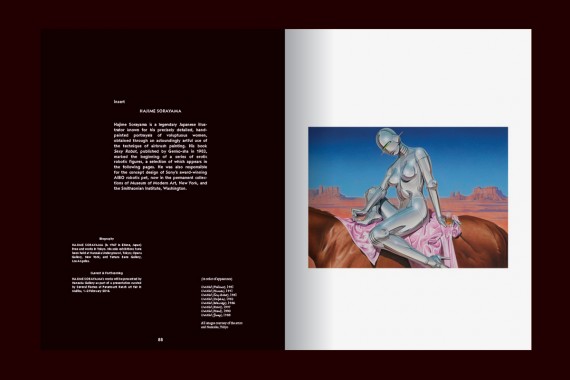
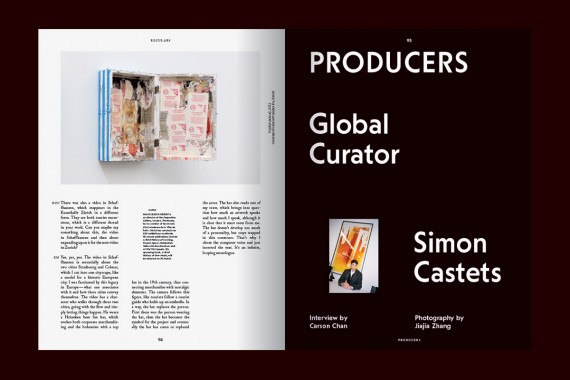
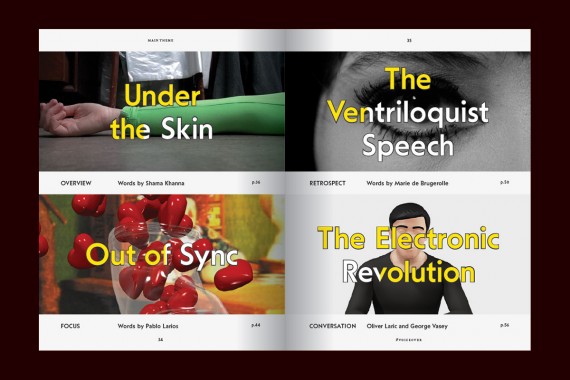
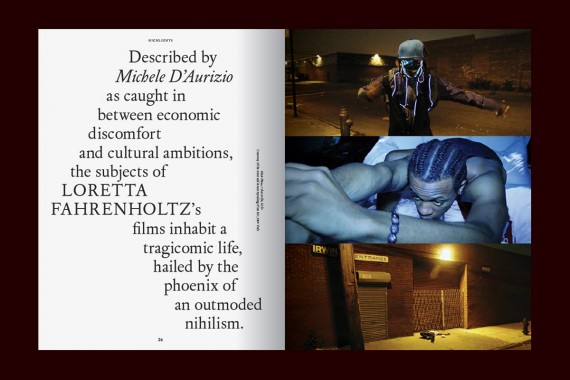

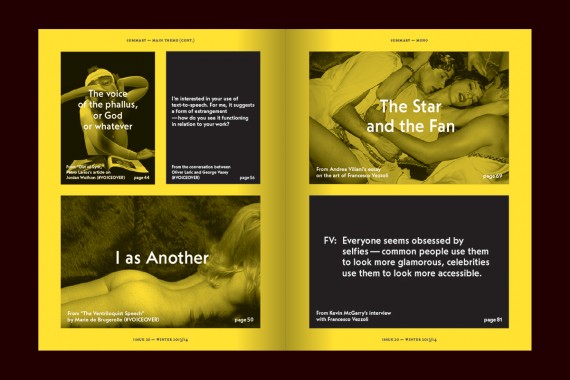
Albert Oehlen, Alessio Ascari, Andrea Viliani, Art, Camille Henrot, Carson Chan, Chris Marker, Christian Falsnaes, Christina Ramberg, David Robilliard, Distribution, Duncan Campbell, Ed Atkins, Ella Kruglyanskaya, Francesco Vezzoli, Fredi Fischli, George Vasey, Hajime Sorayama, Hans Ulrich Obrist, Haroon Mirza, Jean-Luc Godard, Jordan Wolfson, KALEIDOSCOPE Press, Kaspar Müller, Kevin McGarry, Laure Prouvost, Loretta Fahrenholtz, Marie de Brugerolle, Mathieu Malouf, Matthew Barney, Matthew Erickson, Michele D'Aurizio, Ned Vena, Niels Olsen, Oliver Laric, Pablo Larios, Pilvi Takala, Raimar Stange, Shama Khanna, Simon Castets, Thom O'Nions
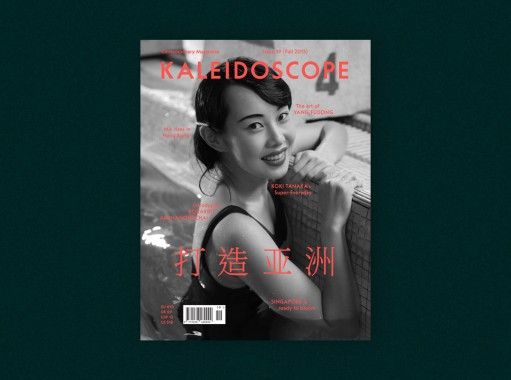
KALEIDOSCOPE Magazine 19 — Fall 2013
Softcover, 242 pp. + three special inserts, offset 4/4, 220 x 287 mm
English edition
ISSN 2038-4807
Published by KALEIDOSCOPE Press
$18.00 ·
KALEIDOSCOPE issue 19 (Fall 2013), is a special edition dedicated to contemporary art and culture produced in the Asia Pacific region. The release of this special edition — the first product of an ongoing investigation, evidencing KALEIDOSCOPE’s commitment towards establishing a presence in Asia — will be celebrated with a series of international launches and will inaugurate, in addition to the standard international circulation of the magazine, an extended distribution in Asian countries.
The opening section of HIGHLIGHTS features: LA-based Japanese artist Koki Tanaka, who pursues the Super-Everyday to find beauty in the ordinary, as explained by Miwako Tezuka; Chinese artist Li Ran, framed by Ho Rui An as attempting to get over the “postcolonial hangover”; Basir Mahmood, who directs his pragmatist gaze upon what Gemma Sharpe describes as the sociological imperatives of Pakistan’s urban life; Korean New Zealand artist Seung Yul Oh, whose practice is read by Emma Bugden as blurring the lines of art and play; and Filipino artist Maria Taniguchi, whose patterns and repetitions are, according to Joselina Cruz, elements of her latent archeology.
Evocatively titled The Making of Asia, the MAIN THEME section discusses the creation and diffusion of local narratives in the Asia Pacific region: editor-in-chief Alessio Ascari interviews Lars Nittve, the director of Hong Kong’s megamuseum M+; art duo Desire Machine Collective talk to Shai Heredia, the founder of India’s most cutting-edge film festival; Gavin Wade speaks to Cao Fei about his new film and the problem of urbanization in metropolitan China; and a panel discussion brings together art initiatives from in and beyond the region — Arthub Asia, Guggenheim UBS Map, Asia Art Archive, and Tate Research Centre: Asia Pacific — around the idea of network.
Sitting between the traditions of cinema and visual art, the work of Chinese artist Yang Fudong — the protagonist of this issue’s MONO — resonates with the cinematic and photographic tropes of a city and society that is also “in between”: the decadent aura of Shanghai in the 1920s and 1930s. As discussed in an essay by Davide Quadrio and Noah Cowan and an interview by Li Zhenhua, Fudong’s crisp black-and-white 35mm films enact a subtle interplay between the political and the abstract, revealing the artist’s passionate attraction to beauty and a rarified approach to the haunting questions of contemporary life.
Lastly, this issue’s section of REGULARS features Hans Ulrich Obrist introducing Thai artist Korakrit Arunanondchai; Gary Carrion-Murayari staging a three-way interview with art collectives The Propeller Group (Vietnam) and CAMP (India); Carson Chan meeting cultural activist Ou Ning; Melanie Pocock reporting on the art scene in Singapore; and Fredi Fischli and Niels Olsen rediscovering the art of cult psychedelic artist Keiichi Tanaami.
The issue is enriched by our seasonal TIPS on following, reading, listening, stopping by, meeting and visiting; as well as by three SPECIAL INSERTS, including a selection of paintings by Chinese artist Wang Xingwei; pictures by Japanese photographer Keizo Kitajima; and a series of digital collages by Filipino artist Pio Abad.
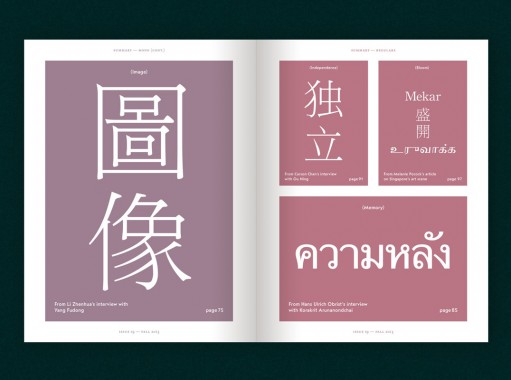
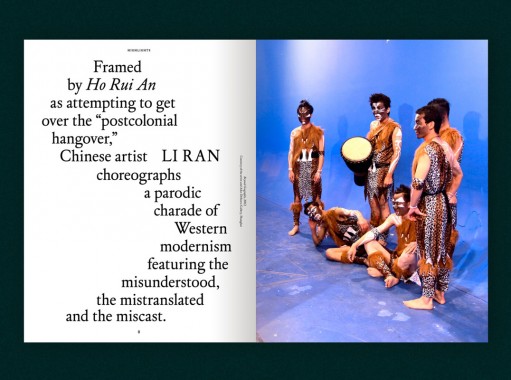
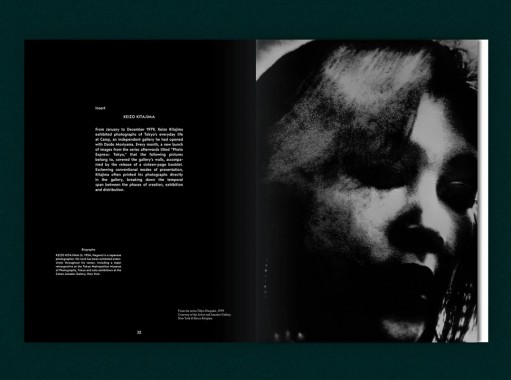
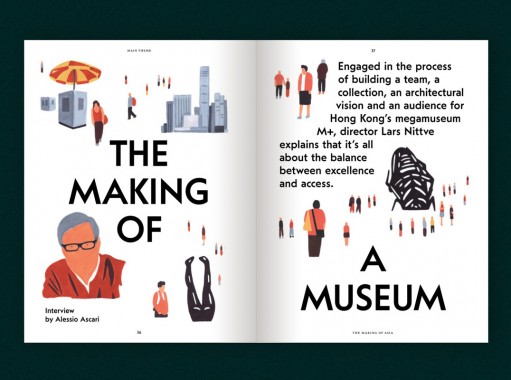
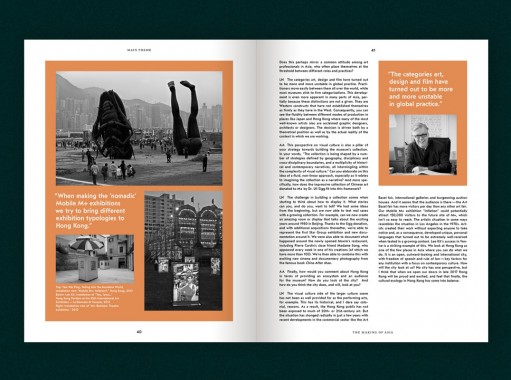
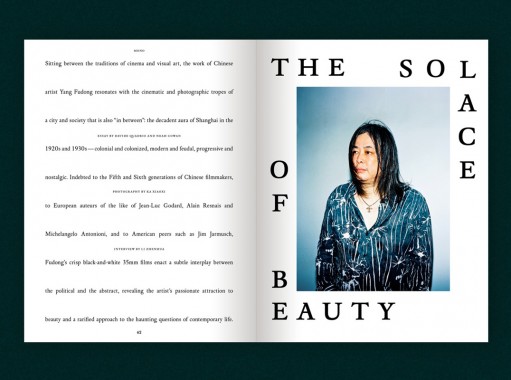
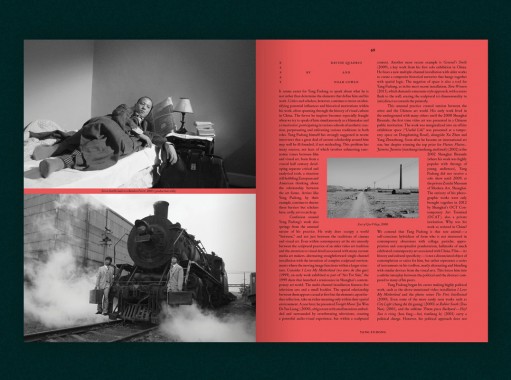
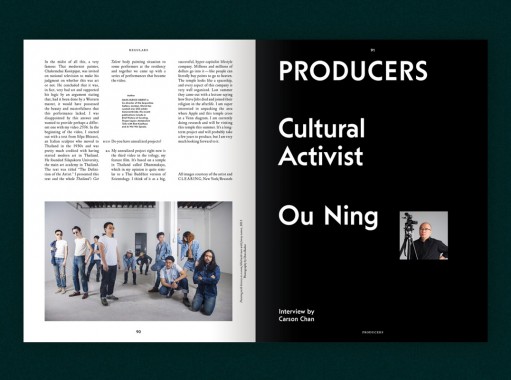
Alessio Ascari, Art, Asia, Basir Mahmood, CAMP, Cao Fei, Carson Chan, Davide Quadrio, Desire Machine Collective, Distribution, Emma Bugden, Fredi Fischli, Gary Carrion-Murayari, Gavin Wade, Gemma Sharpe, Hans Ulrich Obrist, Ho Rui An, Joselina Cruz, KALEIDOSCOPE Press, Keiichi Tanaami, Keizo Kitajima, Koki Tanaka, Korakrit Arunanondchai, Li Ran, Li Zhenhua, Maria Taniguchi, Melanie Pocock, Miwako Tezuka, Niels Olsen, Noah Cowan, Ou Ning, Pio Abad, Seung Yul Oh, Shai Heredia, The Propeller Group, Wang Xingwei, Yang Fudong
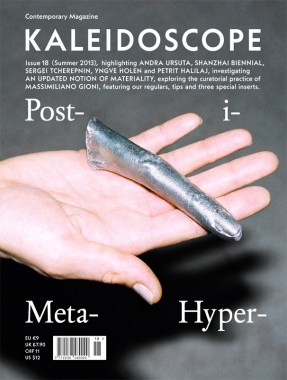
KALEIDOSCOPE Magazine 18 — Summer 2013
Softcover, 228 pp. + three special inserts, offset 4/4, 220 x 287 mm
English edition
ISSN 2038-4807
Published by KALEIDOSCOPE Press
$12.00 ·
KALEIDOSCOPE Issue 18 (summer 2013), highlighting Andra Ursuta, Shanzhai Biennial, Sergei Tcherepnin, Yngve Holen and Petrit Halilaj; investigating an updated notion of materiality; exploring the curatorial practice of Massimiliano Gioni; featuring our regulars, tips, and three special inserts.
HIGHLIGHTS
The issue’s opening section of HIGHLIGHTS features Andra Ursuta, whose practice is understood by Joanna Fiduccia as committed to annihilating sculpture’s distance from our world; the fashion-label-cum-art-project Shanzhai Biennial, whose tangible products, explains Kevin McGarry, are eclipsed by their collateral evidence; Sergei Tcherepnin, described by Lawrence Kumpf as creating a complex system of bodily configurations and social situations; Yngve Holen, whose works are read by Pablo Larios as sentient beings concerned with frustrated circulation, technological growth and associative networking; and Petrit Halilaj whose practice is framed by Elena Filipovic as rejecting pathos in favor of an intimate and critical inflection of the political.
MAIN THEME
This section, titled Post-i-Meta-Hyper-Materiality, brings together a substantial group of artists who introduce the concept of emotional and bodily alienation within the discourse dominated by the readymade, corporate art pursued by many of their digital-native peers. The elusive sculptural works of Nicholas Deshayes, Steve Bishop, Marlie Mul, Magali Reus, Ben Schumacher and Alice Channer are framed by Karen Archey as deeply engaged with materiality and production processes and imbued with bodily allusions, while also commenting on issues of abstraction, dispersion, consumption and technology. A visual essay curated by fashion futurologist Veronica So reveals how, from sculptures designed by digital simulations to edible candies formed by human body scans, the appearance of 3D printing kicks off a range of playful experiments with technology and originality. Also in this section, Alice Channer talks to Rebecca Geldard about the starting point of each work, which she describes as “a moment of material seduction”; and artists Pamela Rosenkratz and Alisa Baremboym discuss physicality versus technology and the shifting boundaries between our bodies and the external world in a cross-interview by Ruba Katrib.
MONO
Comprising an essay by Jonathan Griffin, an interview by Francesco Manacorda and a photographic portrait by Ari Marcopoulos, this issue’s MONO is devoted to the Director of the International Art Exhibition at this year’s Venice Biennale, Massimiliano Gioni. Pragmatic bordering on opportunistic throughout his adventurous career, and yet described as “a hopeless romantic” by one of his most affectionate colleagues, Gioni states that his own failure to understand is what fuels his interest in art. Generally averse to chronological or historically comprehensive presentations and departing from the tautology of the masterpiece, he is instead a proponent of Outsider and self-taught art. His exhibitions, which he defines as products of a collective intelligence, are often concerned with the position of art within our image-based society, as well as the sites of an exploration of interior worlds, dream states and psychological visions.
REGULARS
Finally, it this issue’s REGULARS, Hans Ulrich Obrist and Simon Castets interview emerging artist Amalia Ulman; Gary Carrion-Murayari stages a three-way interview with Valentin Carron and Isabelle Cornaro; Felix Burrichter meets design critic Alice Rawsthorn; Leung Chi Wo, David Clarke and Lam Tung-pang engage in a round table about the art scene in Hong Kong then and now; finally, Laura McLean-Ferristraces the legacy of folk in British contemporary art from the exhibition Black Eyes and Lemonade to the practice of Jeremy Deller.
SPECIAL INSERTS
The edition is enriched by our seasonal TIPS on following, reading, listening, stopping by, meeting and visiting; as well as by three SPECIAL INSERTS, including a selection of paintings by Benjamin Senior, photographs by Jochen Lempert and collages by Sterling Ruby.
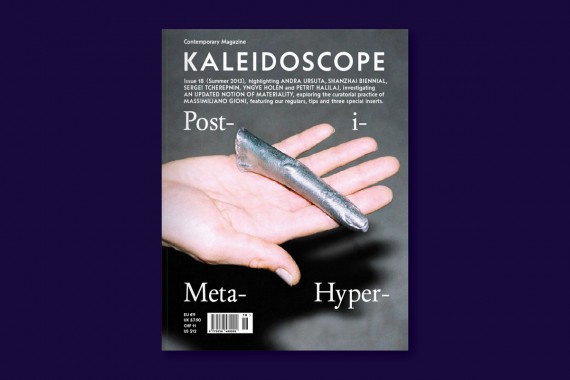
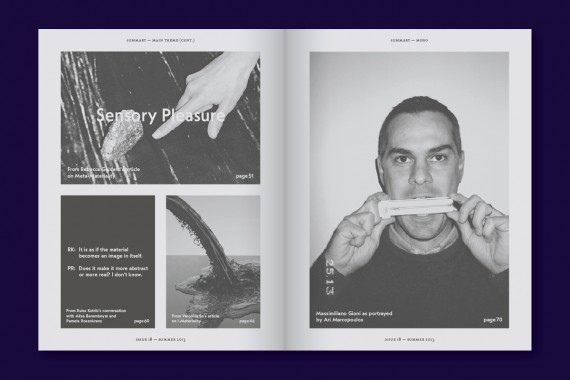
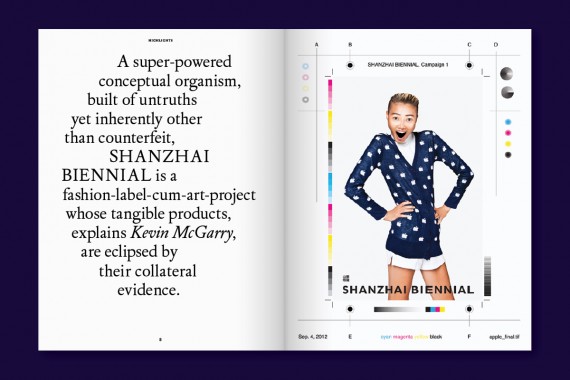
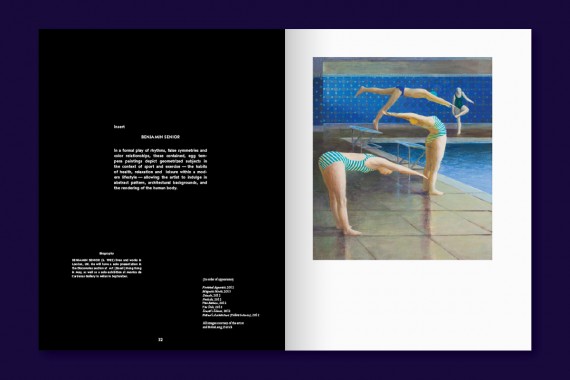
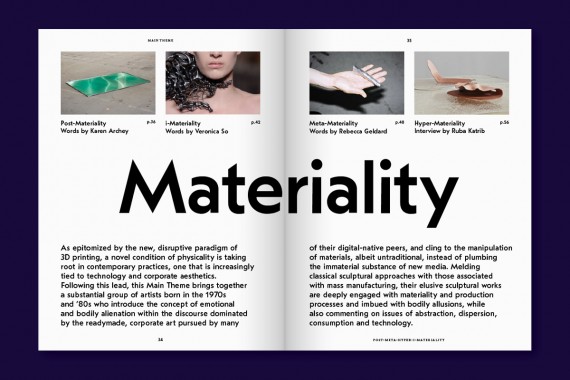
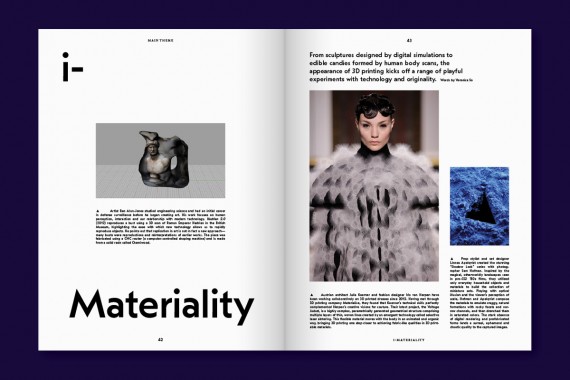
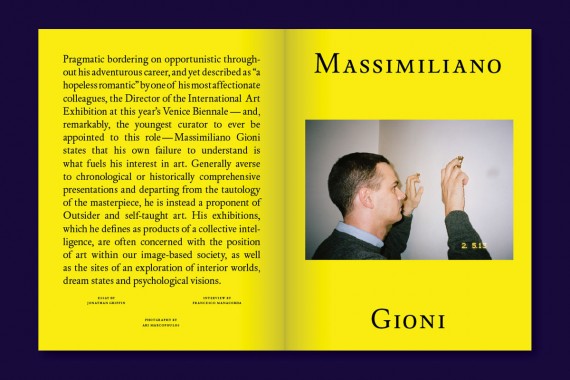
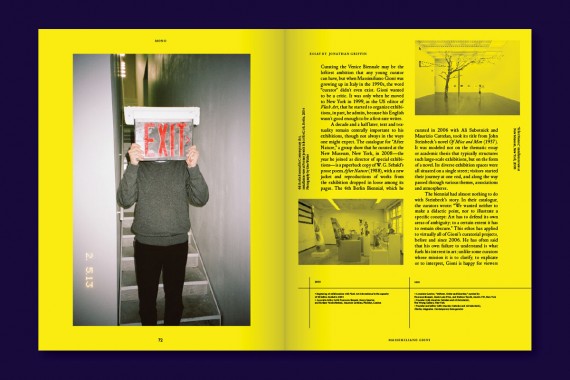
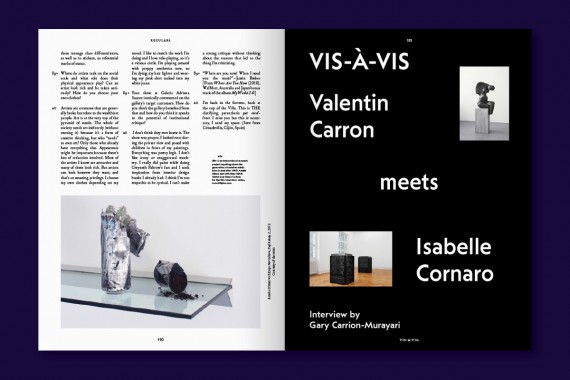
Alice Channer, Alice Rawsthorn, Alisa Baremboym, Amalia Ulman, amela Rosenkratz, Andra Ursuta, Ari Marcopoulos, Art, Ben Schumacher, Benjamin Senior, Culture, David Clarke, Distribution, Elena Filipovic, Felix Burrichter, Francesco Manacorda, Gary Carrion-Murayari, Hans Ulrich Obrist, Isabelle Cornaro, Jeremy Deller, Joanna Fiduccia, Jochen Lempert, Jonathan Griffin, KALEIDOSCOPE Press, Karen Archey, Kevin McGarry, Lam Tung-pang, Laura McLean-Ferristraces, Lawrence Kumpf, Leung Chi Wo, Magali Reus, Marlie Mul, Massimiliano Gioni, Nicholas Deshayes, Pablo Larios, Petrit Halilaj, Rebecca Geldard, Ruba Katrib, Sergei Tcherepnin, Shanzhai Biennial, Simon Castets, Sterling Ruby, Steve Bishop, Valentin Carron, Veronica So, Yngve Holen

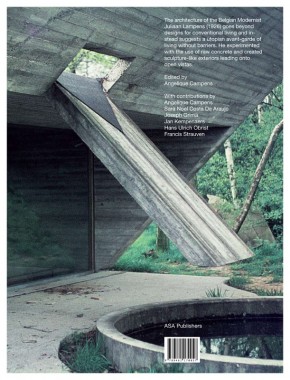
Juliaan Lampens
Softcover, 152 pp., offset 4/1, 210 x 275 mm
Edition of 2000
ISBN 978-94-6117-005-7
Published by ASA Publishers
$40.00 · out of stock
The architecture of the Belgian Modernist Juliaan Lampens (b. 1926) goes beyond designs for conventional living and instead suggests a utopian avant-garde of living without barriers. He experimented with the use of raw concrete and created sculpture-like exteriors leading onto open vistas. Edited by Angelique Campens. With contributions by Angelique Campens, Sara Noel Costa De Araujo, Joseph Grima, Jan Kempenaers, Hans Ulrich Obrist and Francis Strauven.
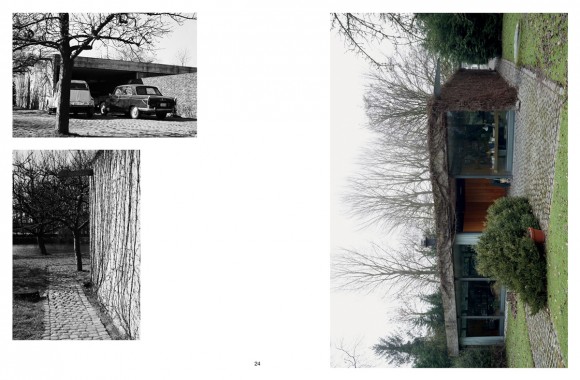
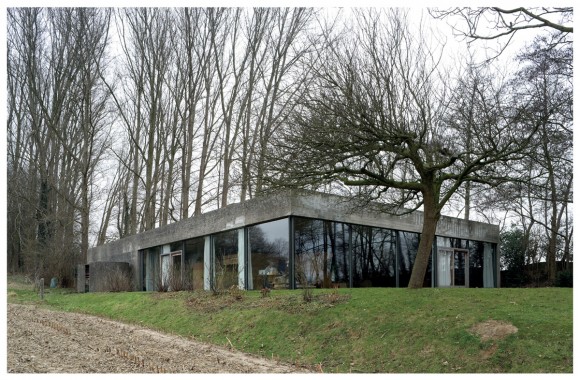
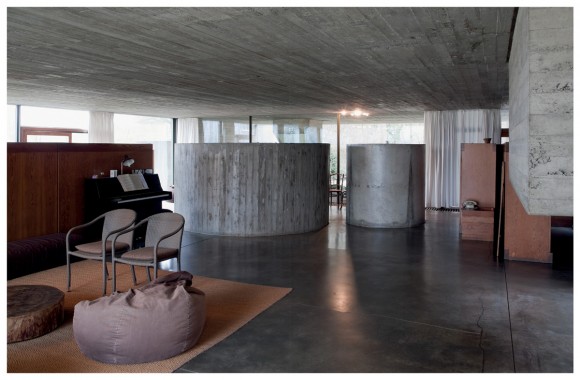
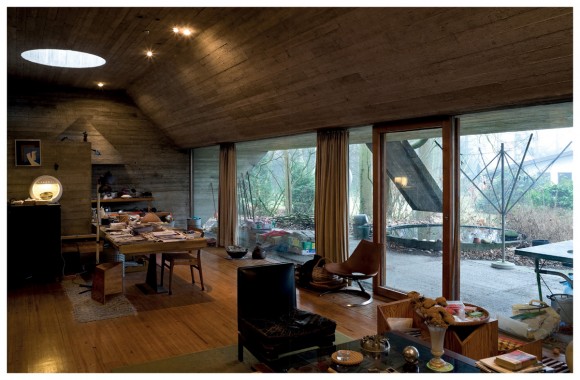

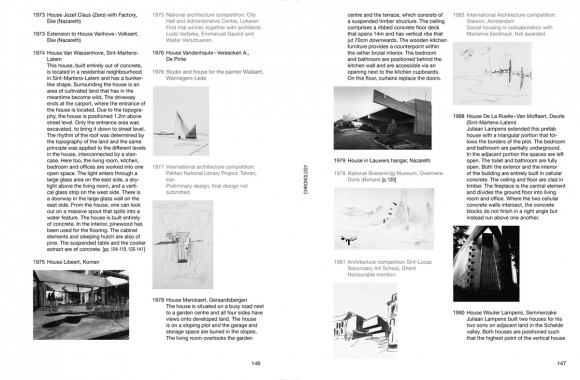
Angelique Campens, Architecture, ASA Publishers, Culture, Distribution, Francis Strauven, Hans Ulrich Obrist, Jan Kempenaars, Joseph Grima, Juliaan Lampens, MER. Paper Kunsthalle, Thomas Desmet
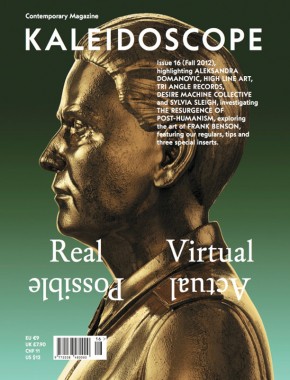
KALEIDOSCOPE Magazine 16 — Fall 2012
Softcover, 210 pp. + Ken Price Drawings insert, offset 4/4, 220 x 287 mm
ISSN 2038-4807
Published by KALEIDOSCOPE Press
$12.00 ·
At the core of a platform that includes an exhibition space and an independent publishing house, KALEIDOSCOPE is an international quarterly of contemporary art and culture founded in 2009 in Milan. Distributed worldwide on a seasonal basis, it has gained widespread recognition as a trusted and timely guide to the present (but also to the past and possible futures), unique in its interdisciplinary and unconventional approach.
HIGHLIGHTS
This issue’s opening section features Aleksandra Domanovic, whose videos and sculptures are seen by Pablo Larios as embodiments of the perpetually productive disunion of politics and art; the ambitious public art program of New York’s High Line, described by Piper Marshall as one that confronts artists with many challenges; the record label Tri Angle, whose founder Robin Carolan talks to Ruth Saxelby about how to embody the zeitgeist of electronic music; the Indian duo Desire Machine Collective, who discuss with Sandhini Poddar and Ulrich Baer about mapping an experimental history of colonization; and American painter Sylvia Sleigh, whose elusive politics is contrasted by Joanna Fiduccia to the detailed realism of her portraits.
MAIN THEME
The blend of cybernetics and underground culture realized in the symbolic and mythological repertoire of Cyberpunk continues to inspire sci-fi narratives and permeate the arts, reinforcing its status as a powerful aesthetic. This issue examines the emergence of an art that addresses the processes of mechanization, desexualisation and reification of the human body, and how they relate to questions of identity, morality and fantasy. Featured contributions include Michele D’Aurizio’s overview of the work of a new generation of artists; Karen Archey’s analysis of the work of Canadian artist David Altmejd; a discussion between Brody Condon and Jason Brown coordinated by DIS magazine; and a conversation between young artist Timur Si-Qin and influential philosopher Manuel De Landa.
MONO
Comprising an essay by Alessandro Rabottini, an interview by Matt Keegan and a photographic portrait by Grant Willing, this issue’s MONO is devoted to American artist Frank Benson, whose work rides the dialectic between the space of the photographic image and the space of sculpture. Evoking celebrated artists like Charles Ray, Jeff Koons and Robert Gober, Benson uses the latest technology available and yet imbues the sculptural process with a profound understanding of physical materiality — making works that oscillate between analogue and digital, solidity and suspension, humor and elegance.
REGULARS
Hans Ulrich Obrist interviews the New York-based provocateur Liz Magic Laser; Dorothée Dupuis introduces the hidden life of Marseille; Luca Cerizza analyzes the emotional topography of Alberto Garutti; and Carson Chan meets the DAAD’s visual arts director Ariane Beyn. The edition is enriched by our seasonal tips on following, reading, listening, stopping by, meeting and visiting; as well as by three special inserts — drawings by Ken Price, stickers by Alistair Frost and images by Alistair Frost.
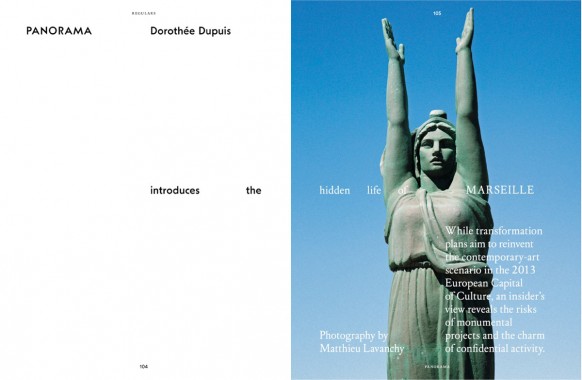
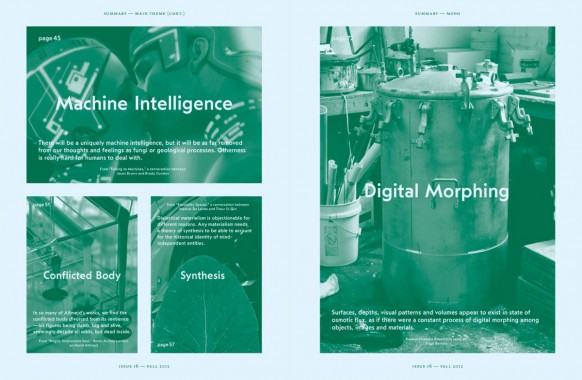
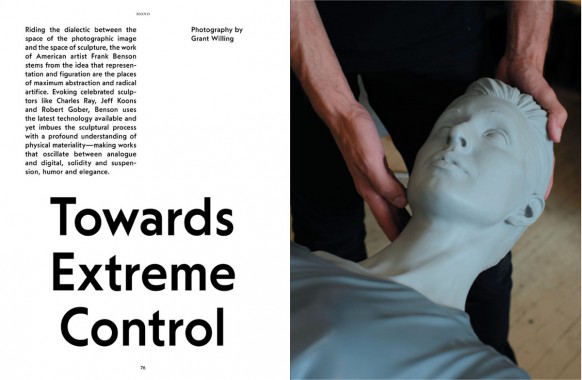
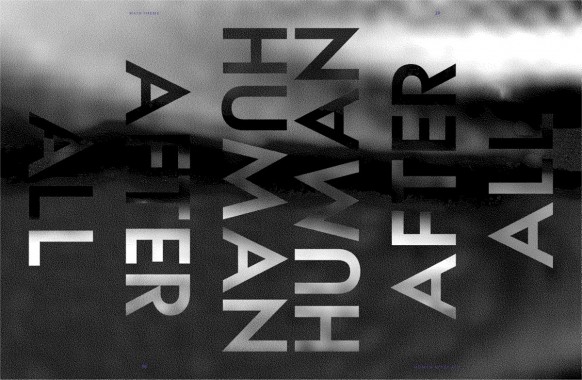
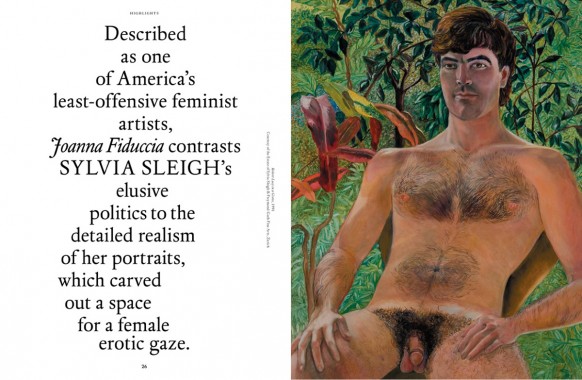
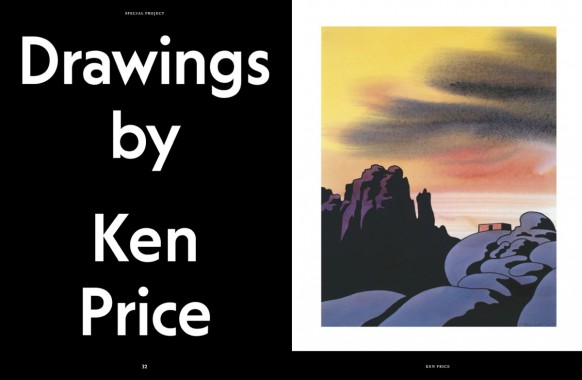
Alberto Garutti, Aleksandra Domanovic, Alessandro Rabottini, Alistair Frost, Ariane Beyn, Art, Brody Condon, Carson Chan, Charles Ray, Cyberpunk, David Altmejd, Desire Machine Collective, DIS Magazine, Distribution, Dorothée Dupuis, Drawing, Frank Benson, Grant Willing, Hans Ulrich Obrist, Jason Brown, Jeff Koons, Joanna Fiduccia, KALEIDOSCOPE Press, Karen Archey, Ken Price, Liz Magic Laser, Luca Cerizza, Manuel De Landa, Matt Keegan, Michele D'Aurizio, Pablo Larios, Piper Marshall, Robert Gober, Robin Carolan, Ruth Saxelby, Sandhini Poddar, Sculpture, Sylvia Sleigh, Timur Si-Qin, Tri Angle, Ulrich Baer
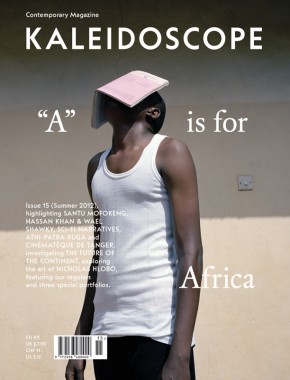
KALEIDOSCOPE Magazine 15, “A” is for Africa
Summer 2012 — Africa Special Edition
Softcover, 202 pp., offset 4/4, 220 x 287 mm
ISSN 2038-4807
Published by KALEIDOSCOPE Press
$12.00 · out of stock
Editor-in-Chief Alessio Ascari and art directors OK-RM are pleased to announce that KALEIDOSCOPE’s summer issue is a special edition entirely devoted to art produced in (or related to) the African continent today. In a time when the once-dominant western model is collapsing, the impressive growth of Africa’s economies looks likely to continue and its cultural offer is growing more and more vibrant, exposing the international audience to an incredible offering of art, music, architecture, film, design and fashion. This issue intends to be the most up-to-date and thorough exploration of the African scene of contemporary art and culture, from Egypt to South Africa via Ethiopia and Nigeria, conducted in collaboration with a dream team of both international contributors and influential thinkers and practitioners working in and around Africa today.
HIGHLIGHTS
Santu Mofokeng by Philippe Pirotte; Hassan Khan and Wael Shawky by Shahira Issa; Sci-Fi Narratives by Nav Haq and Al Cameron; Athi-Patra Ruga by Linda Stupart; Cinématèque de Tanger by Omar Berrada.
MAIN THEME — The Future of the Continent, Continent of the Future
Art by Nana Oforyatta-Ayim; Cinema by Olufemi Terry, Frances Bodomo, Jean-Pierre Bekolo and Mahen Bonetti; Music by Benjamin Lebrave; and Urban Planning by Antoni Folkers.
MONO — Nicholas Hlobo
Interview by Sean O’Toole; Essay by Tracy Murinik; Focus by Liese van deer Watt.
REGULARS
Futura: Lynette Yiadom-Boakye by Hans Ulrich Obrist; Panorama: Invisible Borders by Emmanuel Iduma; Souvenir d’Italie: Massimo Grimaldi by Luca Cerizza; On Exhibitions: “African Negro Art” by Paola Nicolin; Producers: Elvira Dyangani Ose by Carson Chan.
SPECIAL PORTFOLIOS
Viviane Sassen, Rotimi Fani-Kayode and Namsa Leuba.
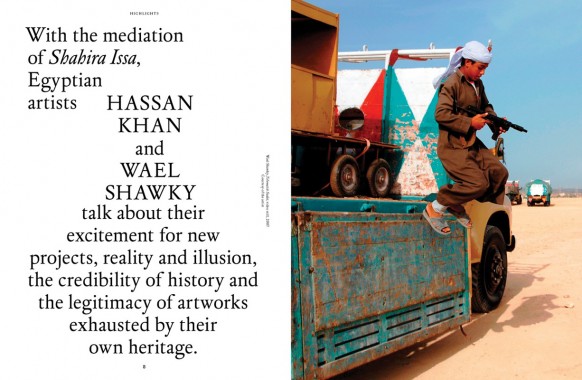
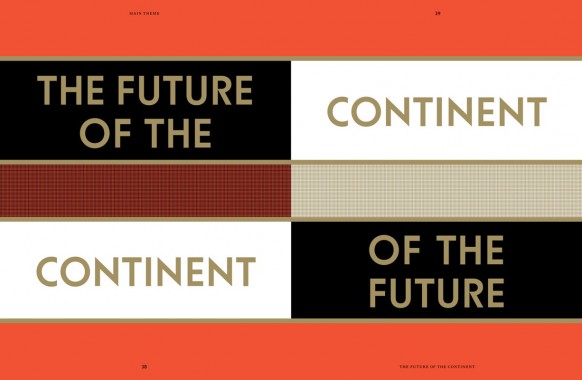
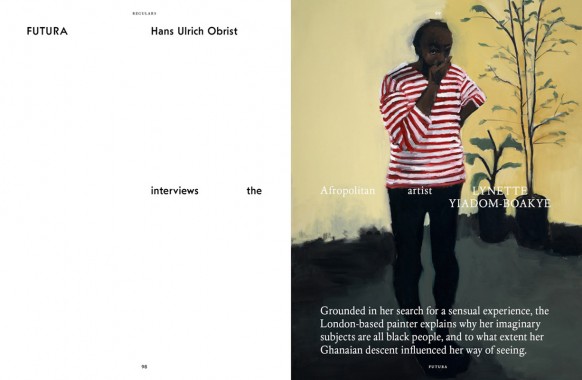
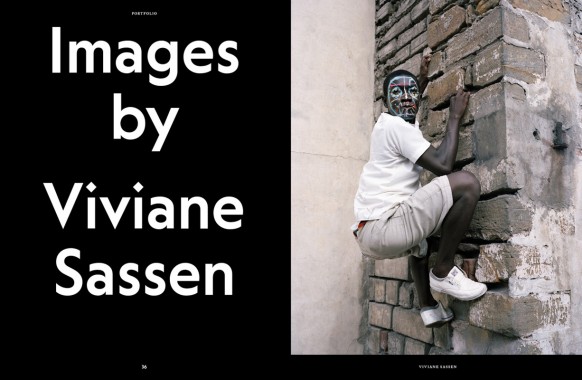
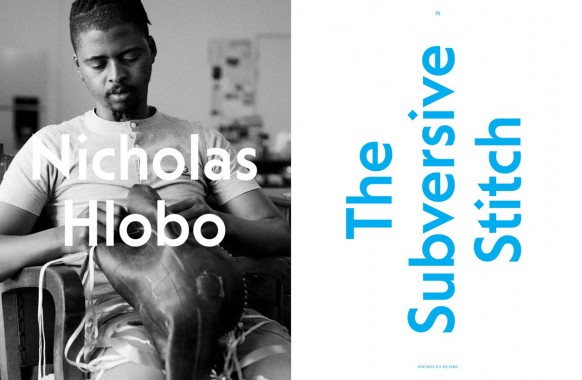
Africa, Al Cameron, Antoni Folkers, Architecture, Art, Athi-Patra Ruga, Benjamin Lebrave, Carson Chan, Cinématèque de Tanger, Distribution, Elvira Dyangani Ose, Emmanuel Iduma, Film, Frances Bodomo, Hans Ulrich Obrist, Hassan Khan, hen Bon, Jean-Pierre Bekolo, KALEIDOSCOPE Press, Liese van deer Watt, Linda Stupart, Luca Cerizza, Lynette Yiadom-Boakye, Mahen Bonetti, Massimo Grimaldi, Namsa Leuba, Nana Oforyatta-Ayim, Nav Haq, Nicholas Hlobo, OK-RM, Oliver Knight, Olufemi Terry, Omar Berrada, Paola Nicolin, Philippe Pirotte, Rory McGrath, Rotimi Fani-Kayode, Santu Mofokeng, Sean O'Toole, Shahira Issa, Viviane Sassen, Wael Shawky
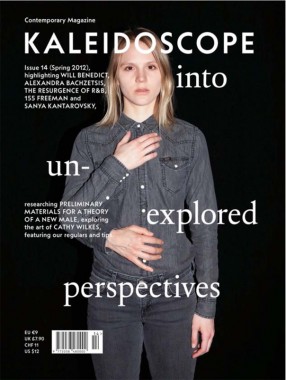
KALEIDOSCOPE Magazine 14 — Spring 2012
Softcover, 168 pp., offset 4/4, 220 x 287 mm
ISSN 2038-4807
Published by KALEIDOSCOPE Press
$12.00 ·
At the core of a platform that includes an exhibition space and an independent publishing house, KALEIDOSCOPE is an international quarterly of contemporary art and culture founded in 2009 in Milan. Distributed worldwide on a seasonal basis, it has gained widespread recognition as a trusted and timely guide to the present (but also to the past and possible futures), unique in its interdisciplinary and unconventional approach.
HIGHLIGHTS
Will Benedict by Alex Kitnick; Alexandra Bachzetsis by Catherine Wood; 155 Freeman by Chris Wiley; The Resurgence of R&B by Tim Small; Sanya Kantarovsky by Joanna Fiduccia.
MAIN THEME — Preliminary Materials for a Theory of a New Male Camp + Dandyism = Neo-Camp? by Chris Sharp; Domenico Gnoli by Giorgio Verzotti; Marc Camille Chaimowicz Partial Eclipse; A Fantastic, Single, Mad Man by Alessio Ascari and Cristina Travaglini.
MONO — Cathy Wilkes
Essay by Rebecca Geldard; Essay by Amy Budd; Special Project by Cathy Wilkes; Focus by Isobel Harbison.
REGULARS
Pioneers: Monir S. Farmanfarmaian by Simone Menegoi; Futura: Adrian Villar Rojas by Hans Ulrich Obrist; Panorama: Mexico City by Magnolia de la Garza; Souvenir d’Italie: Alighiero Boetti by Luca Cerizza; Producers: Gavin Brown by Carson Chan.
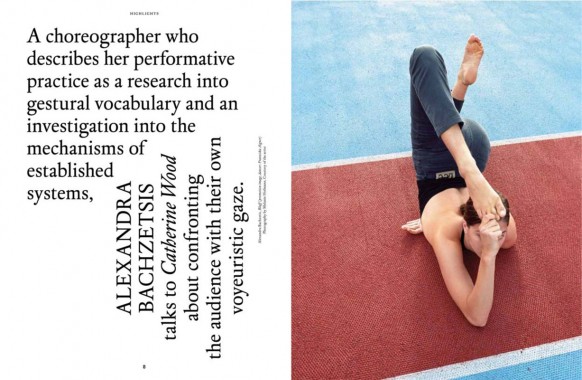
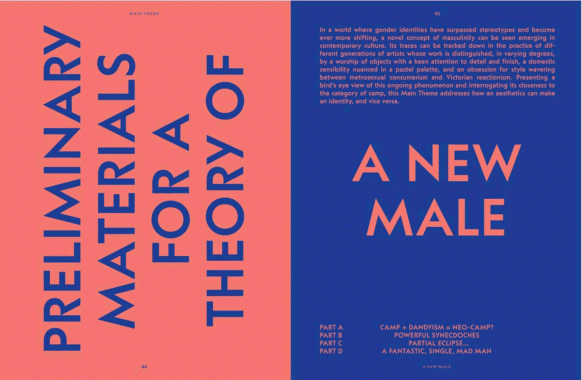
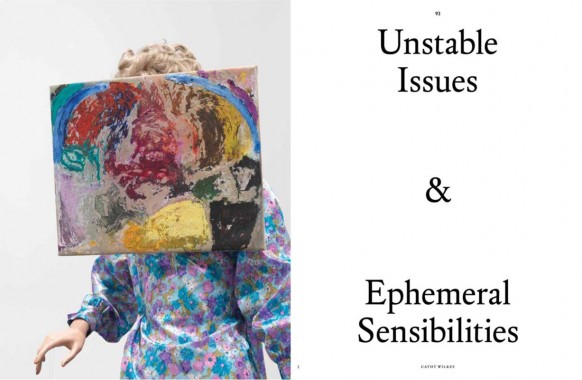
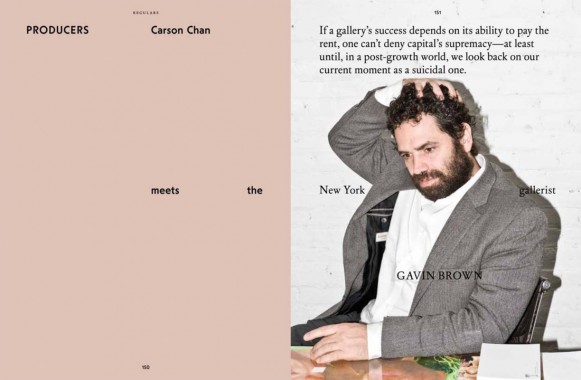
Adrian Villar Rojas, Alessio Ascari, Alex Kitnick, Alexandra Bachzetsis, Alighiero Boetti, Amy Budd, Art, Carson Chan, Catherine Wood, Cathy Wilkes, Chris Sharp, Chris Wiley, Cristina Travaglini, Culture, Distribution, Domenico Gnoli, Gavin Brown, Giorgio Verzotti, Hans Ulrich Obrist, Isobel Harbison, Joanna Fiduccia, KALEIDOSCOPE Press, Luca Cerizza, Magnolia de la Garza, Marc Camille Chaimowicz, Monir S. Farmanfarmaian, Rebecca Geldard, Sanya Kantarovsky, Simone Menegoi, Tim Small, Will Benedict
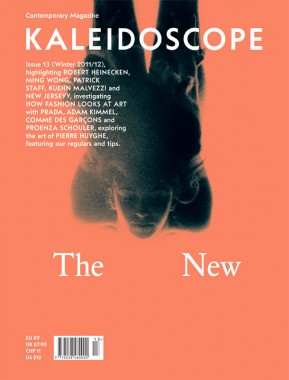
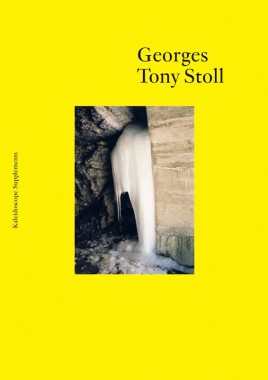
Kaleidoscope Magazine 13, The New
Softcover, 262 pp., offset 4/4, 220 x 287 mm
Softcover, 48 pp., offset 4/4, 190 x 270 mm [Georges Tony Stoll supplement]
ISSN 2038-4807
ISBN 978-88-97185-18-5
Published by Kaleidoscope Press
$12.00 ·
At the core of a platform that includes an exhibition space and an independent publishing house, Kaleidoscope is an international quarterly of contemporary art and culture founded in 2009 in Milan. Distributed worldwide on a seasonal basis, it has gained widespread recognition as a trusted and timely guide to the present (but also to the past and possible futures), unique in its interdisciplinary and unconventional approach.
For the Winter 2011/12, editor-in-chief Alessio Ascari is proud to present the first issue of Kaleidoscope magazine under the art direction of the prominent London-based design studio OK-RM — Oliver Knight and Rory McGrath.
HIGHLIGHTS
Robert Heinecken by Kavior Moon; Ming Wong by Hu Fang; Kuehn Malvezzi by Hila Peleg; New Jerseyy by Quinn Latimer; Patrick Staff by Catherine Wood.
MAIN THEME — How Does Fashion Look at Art?
Adam Kimmell by Angelo Flaccavento; Commes des Garçons by Maria Luisa Frisa; Proenza Schouler by Michele D’Aurizio.
MONO — Pierre Huyghe
Essay by Éric Troncy; Interview by Barbara Casavecchia; Special Project: Study for Zoodram; Focus by Chris Wiley.
REGULARS
Pioneers: Bruce McLean by Simone Menegoi; Futura: Ed Atkins by Hans Ulrich Obrist; Panorama: Toronto by Amil Niazi; Souvenir d’Italie: Luigi Ghirri by Luca Cerizza; Producers: Ute Meta Bauer by Carson Chan.
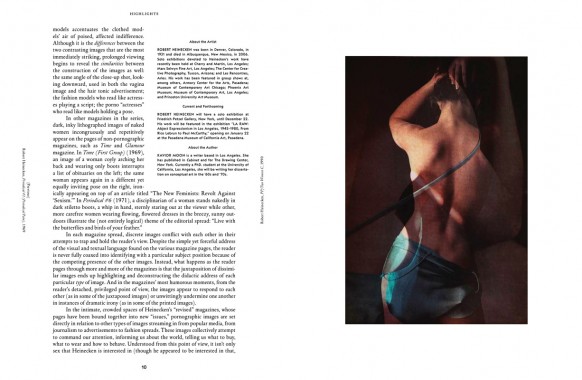
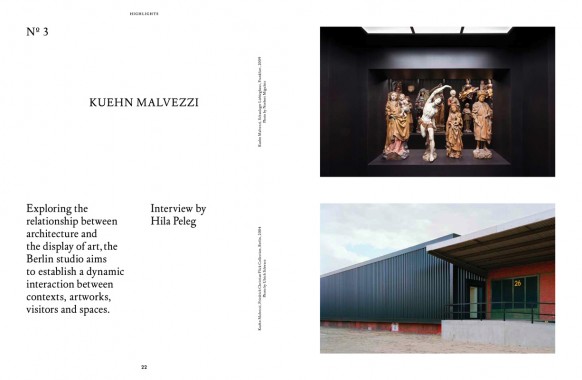
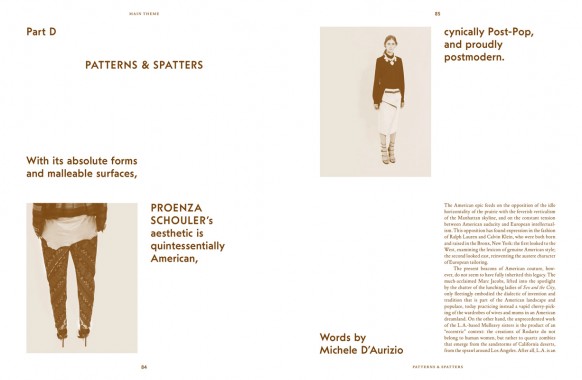
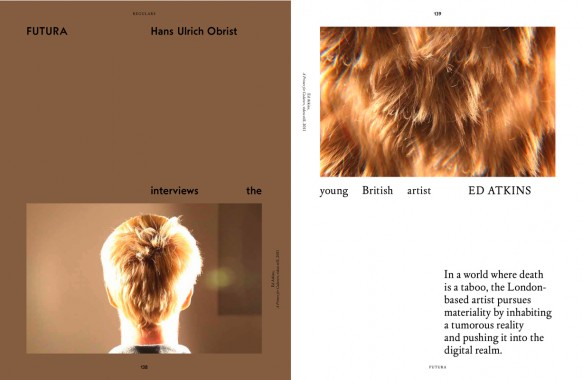
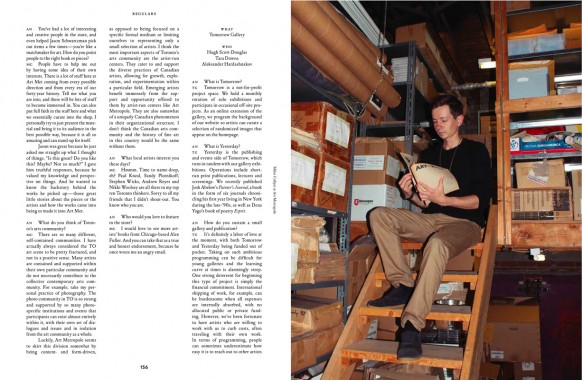
Adam Kimmell, Alessio Ascari, Aliina Astrova, Amil Niazi, Angelo Flaccavento, Art, Barbara Casavecchia, Bruce McLean, Carson Chan, Catherine Wood, Chris Wiley, Commes des Garçons, Cristina Travaglini, Culture, Distribution, Ed Atkins, Éric Troncy, Francesco Vezzoli, Georges Tony Stoll, Hans Ulrich Obrist, Hila Peleg, Hu Fang, Joanna Fiduccia, KALEIDOSCOPE Press, Kavior Moon, Klingspor, Kuehn Malvezzi, Laurenz Brunner, Luca Cerizza, Luigi Ghirri, Maria Luisa Frisa, Michele D'Aurizio, Ming Wong, Nicholas Cullinan, OK-RM, Oliver Knight, Patrick Staff, Photography, Pierre Huyghe, Proenza Schouler, Quinn Latimer, Robert Heinecken, Rory McGrath, Simone Menegoi, Ute Meta Bauer
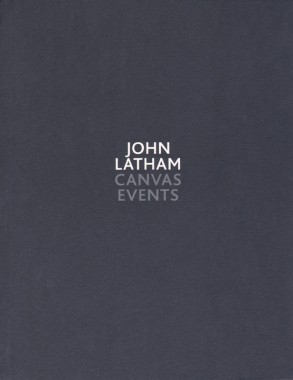
John Latham, Canvas Events
Softcover, 24 pp., offset 4/1, 215 x 275 mm
Edition of 1000
ISBN 978-1-905464-31-9
Published by Ridinghouse
$22.00 ·
Published on the occasion of the exhibition
John Latham, Canvas Events
at Karsten Schubert / Richard Saltoun
5 May — 11 June 2010
This small but impeccably produced catalog introduces a never-before-exhibited series of works by the late British artist John Latham (1921-2006). The 1994 works called, Canvas Events, features spray-painted and twisted canvas on wooden stretchers. The works challenge the conventional relationship between canvas and stretcher, turning the traditional site of the painting into a sculptural field. Latham often worked with spray paint; he often described the dotted sprinkled result as miniature universes. Reproductions of the 1994 Canvas Events are accompanied by a conversation between Latham, Hans Ulrich Obrist and Barbara Steveni, in which they discuss the artist’s work over time.
Art, Barbara Steveni, Hans Ulrich Obrist, Interview, John Latham, Karsten Schubert, RAM, Richard Saltoun, Ridinghouse, Tim Harvey
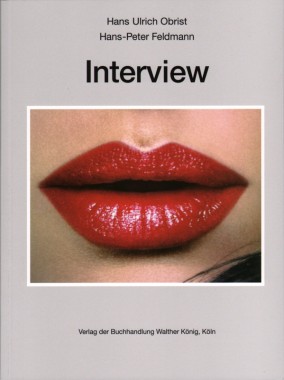
Hans Ulrich Obrist and Hans-Peter Feldmann, Interview
Softcover, 130 pp., offset 4/1, 165 x 220 mm
English and German
Edition of 2000
ISBN 978-3-86560-660-0
Published by Walther König
$49.00 · out of stock
Hans Ulrich Obrist and Hans-Peter Feldmann, who have known each other for around 20 years, talked about the possibility of an interview for quite some time. They finally decided that Obrist pose the questions in writing, and Feldmann answer each of them with a picture.
Art, DAP, Hans Ulrich Obrist, Hans-Peter Feldmann, Interview, Photography, Pictures, Walther König
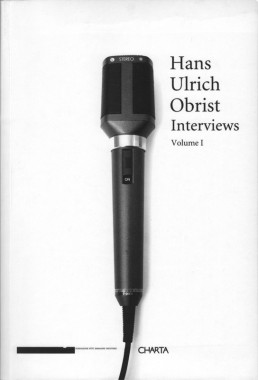
Hans Ulrich Obrist, Interviews Volume I
Softcover, 968 pp., offset 1/1, 140 x 205 mm
Edition of 2000
ISBN 9788881584314
Published by Charta
$59.00 · out of stock
It is not an exaggeration to write that Hans Ulrich Obrist is everywhere, has curated everything and has interviewed everyone. If “peripatetic” is the word most overused to describe him, it is not inappropriate. The Swiss-born, everywhere-based curator and head of the Programme Migrateurs at the Musée d’Art Moderne de la Ville de Paris has an unstoppable wanderlust and a related symptom: his penchant for interviewing anyone and everyone who piques his curiosity, be they artist, scientist, writer, curator, composer, architect, thinker, etc. Since 1993, Obrist has conducted more than 300 interviews, 75 of which are collected here in a selection that respects the cultural and professional diversity of the interviewees. Each interview is introduced by a short text outlining the biography of the interviewee and giving some contextual information on the recording of the interview.
Art, Brian Eno, Charta, Daniel Buren, DAP, Felix Gonzalez-Torres, Gerhard Richter, Hans Ulrich Obrist, Interviews, Jonas Mekas, Lawrence Weiner, Mario Merz, Matthew Barney, Maurizio Cattelan, Olafur Eliasson, Rem Koolhaas, Vito Acconci, Walter Hopps, Yoko Ono, Zaha Hadid












































































